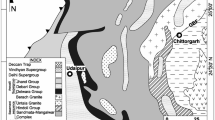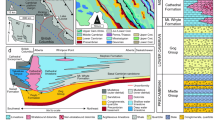Abstract
Field and drill core hyperspectral sensing technologies are cost-effective tools for identifying footprints of hydrothermal mineral systems, vectoring towards potential ore bodies and differentiating domains in ore deposits. Hyperspectral visible-near, shortwave and thermal infrared data were collected from drill core and chip samples from the Cu-Zn-Mo deposit of Antamina, Peru, to map the relative abundance and chemical composition of major gangue minerals, such as garnet and quartz. This study focuses on grandite-series garnets (i.e. grossular to andradite), which show distinct variations with regard to their relative abundance and chemical composition across the Antamina deposit. Reflectance spectra were calibrated with quantitative mineralogy derived from scanning electron microscopy and X-ray diffraction-derived mineralogy. This allowed the modal abundances of garnet and quartz to be modelled using a partial least squares approach, achieving regression coefficients of up to 0.887 and 0.891, respectively. The accuracy of the modelled modal mineral abundance depended on the method of external calibration, and the mineral assemblage associated with the mineral of interest. Comparing the hyperspectral data with major sulfide mineralogy, whole-rock geochemistry, electron probe microanalysis and Fourier-transform infrared microscopy allowed the identification of five ore clusters at Antamina, including high Cu ± Zn-Mo; Zn + Cu ± Mo and Zn ± Cu in the exoskarn and Mo ± Cu-Zn and high Mo ± Cu-Zn in the endoskarn. The garnet species comprise mainly grossular ± andradite in the endoskarn and andradite in the exoskarn. Different garnet compositions are associated with different sulfide mineral assemblages, making Antamina an ideal candidate for evaluating hyperspectral sensing for rapid and reliable mineral characterisation of skarn deposits. Vector minerals typical of skarn deposits (e.g. garnet, vesuvianite) were determined using this approach, indicating its potential for effectively characterising skarn deposits worldwide.











Similar content being viewed by others
References
Basile A, Hughes J, McFarlane AJ, Bhargava SK (2010) Development of a model for serpentine quantification in nickel laterite minerals by infrared spectroscopy. Miner Eng 23:407–412
Burley LL, Barnes SJ, Laukamp C, Mole DR, le Vaillant M, Fiorentini ML (2017) Rapid mineralogical and geochemical characterisation of the Fisher East nickel sulphide prospects, Western Australia, using hyperspectral and pXRF data. Ore Geol Rev 90:371–387. https://doi.org/10.1016/j.oregeorev.2017.04.032
Chung FH (1974) Quantitative interpretation of X-ray diffraction patterns of mixtures. I. Matrix-flushing method for quantitative multicomponent analysis. J Appl Crystallogr 7:519–525
Clechenko CC, Valley JW (2003) Oscillatory zoning in garnet from the Willsboro wollastonite skarn, Adirondack Mts, New York: A record of shallow hydrothermal processes preserved in a granulite facies terrane. J Metamorph Geol 21:771–784
Cudahy TJ, Okada K, Yamoto Y, Maekawa M, Hackwell JA, Huntington JF (2000) Mapping Skarn and Porphyry Alteration Mineralogy at Yerington, Nevada, using Airborne Hyperspectral TIR SEBASS Data.- CSIRO report 734R, 78pp.
Cudahy TJ, Okada K, Yamato Y, Cornelius A, Hewson R (2001) Mapping the Skarn-Porphyry-Epithermal Alteration System at Yerington, Nevada, using VNIR-SWIR-TIR Remotely Sensed Data. CSIRO report 1121R, 51pp.
Cudahy T, Hewson R (2002) ASTER geological case histories: porphyry-skarn-epithermal, iron oxide Cu-Au and Broken Hill Pb-Zn-Ag. In: Annual General Meeting of the Geological Remote Sensing Group ‘ASTER Unveiled’, Burlington House, Piccadilly, London, UK.
Cudahy T, Hewson R, Caccetta M et al (2009) Drill core logging of plagioclase feldspar composition and other minerals associated with Archean gold mineralization at Kambalda, Western Australia, using a bidirectional thermal infrared reflectance system. Rev Econ Geol 16:223–235
Dalm M, Buxton MWN, van Ruitenbeek FJA, Voncken JHL (2014) Application of near-infrared spectroscopy to sensor based sorting of a porphyry copper ore. Miner Eng 58:7–16
Escalante A, Dipple GM, Barker SLL, Tosdal R (2010) Defining trace-element alteration halos to skarn deposits hosted in heterogeneous carbonate rocks: Case study from the Cu-Zn Antamina skarn deposit. J Geochem Explor 105:117–136
Geiger CA, Winkler B, Langer K (1989) Infrared spectra of synthetic almandine-grossular and almandine-pyrope garnet solid solutions: evidence for equivalent site behaviour. Min Mag 53:231–237
Green D, Schodlok M (2016) Characterisation of carbonate minerals from hyperspectral TIR scanning using features at 14 000 and 11 300 nm. Aust J Earth Sci 63:951–957
Haaland DM, Thomas EV (1988a) Partial least-squares methods for spectral analyses. 1. Relation to other quantitative calibration methods and the extraction of qualitative information. Anal Chem 60:1193–1202
Haaland DM, Thomas EV (1988b) Partial least-squares methods for spectral analyses. 2. Application to simulated and glass spectral data. Anal Chem 60:1202–1208
Haest M, Cudahy T, Laukamp C, Gregrory S (2012a) Quantitative mineralogy from visible to shortwave infrared spectroscopic data - I. Validation of mineral abundance and composition products of the Rocklea Dome channel iron deposit in Western Australia. Econ Geol 107:209–228
Haest M, Cudahy T, Laukamp C, Gregrory S (2012b) Quantitative mineralogy from visible to shortwave infrared spectroscopic data - II. 3D mineralogical characterisation of the Rocklea Dome channel iron deposit, Western Australia. Econ Geol 107:229–249
Henry RL (1948) The transmission of powder films in the infrared. J Opt Soc Am 33(9):775–789
Jamtveit B (1991) Oscillatory zonation patterns in hydrothermal grossular-andradite garnets: Nonlinear behavior in regions of immiscibility. Am Mineral 76:1319–1327
Jamtveit B, Wogelius RA, Fraser DG (1993) Zonation patterns of skarn garnets: Records of hydrothermal system evolution. Geol 21:113
Laukamp C, Cudahy T, Caccetta M, Chia J, Gessner K, Haest M, Liu YC, Rodger A (2010) The uses, abuses and opportunities for hyperspectral technologies and derived geoscience information. AIG Bulletin, 51(Geo-Computing 2010 Conference, Brisbane, September 2010):73-76.
Laukamp C, Termin KA, Pejcic B, Haest M, Cudahy T (2012) Vibrational spectroscopy of calcic amphiboles - Applications for exploration and mining. Eur J Mineral 24:863–878
Love DA, Clark AH, Glover JK (2004) The lithologic, stratigraphic, and structural setting of the giant Antamina copper-zinc skarn deposit, Ancash, Peru. Econ Geol 99:887–916
McAloon BP, Hofmeister AM (1995) Single-crystal IR spectroscopy of grossular-andradite garnets. Am Min 80:1145–1156
McKee EH, Noble DC, Scherkenbach DA, Drexler JW, Mendoza J, Eyzaguirre VR (1979) Age of porphyry intrusion, potassic alteration, and related Cu-Zn skarn mineralization, Antamina district, northern Peru. Econ Geol 74:928–930
Meinert LD, Hefton KK, Mayes D, Tasiran I (1997) Geology, zonation, and fluid evolution of the Big Gossan Cu-Au skarn deposit, Ertsberg district, Irian Jaya. Econ Geol 92:509–526
Meinert LD, Dipple GM, Nicolescu S (2005) World skarn deposits. Econ Geol 100th Anniversary Volume:299–336.
Mrozek SA, Chang Z, Spandler C, Windle S, Raraz C, Paz A (2020) Classifying skarns and quantifying metasomatism at the Antamina deposit, Peru: Insights from whole-rock geochemistry. Econ Geol 115:177–188
Petersen U (1965) Regional geology and major ore deposits of central Peru. Econ Geol 60:407–476
Patterson KP, Rowins SM, Terry DA (2000) Structural controls on polymetallic skarn mineralization at Cerro el Sacrificio, Durango, Mexico [abs.]: GeoCanada 2000 Conference Calgary, Alberta, Proceedings, Abstract 94 (CD-ROM).
Raudsepp M, Pani E, Dipple GM (1999) Measuring mineral abundance in skarn. I. The Rietveld method using X-ray powder-diffraction data. Can Mineral 37:1–15
Redwood SD (1999) The geology of the Antamina copper-zinc skarn deposit, vol 60. The Gangue, Newsletter of the Mineral Deposits Division, Geological Association of Canada, Peru, pp 1–7
Schodlok MC, Whitbourn L, Huntington J et al (2016) The HyLogger-3 - An integrated VNIR, SWIR and TIR spectrometer system for the National Virtual Core Library - Function and description. Austr J Earth Sci 63(8):929–940
Sutherland DN, Gottlieb P (1991) Application of automated quantitative mineralogy in mineral processing. Miner Eng 4(7–11):753–762
Tappert M, Rivard B, Giles D, Tappert R, Mauger A (2013) The mineral chemistry, near-infrared, and mid-infrared reflectance spectroscopy of phengite from the Olympic Dam IOCG deposit, South Australia. Ore Geol Rev 53:26–38
Vlasova DK, Podlesskiy KV, Kudrya PF, Boronikhin VA, Muravitskaya GN (1985) Zoning in garnets from skarn deposits. Int Geol Rev 27:465–482
Acknowledgements
Lew Whitbourn, Zoe Willie, Warren Wright and Marc Jolivet are sincerely thanked for their great work with scanning the drill cores samples using the HyLogger-3 at CSIRO North Ryde. The authors of this research work acknowledge the AMTC-CSIRO Chile International Centre of Excellence, financed by CORFO Chile (INNOVA CSIRO-CHILE 10CEII-9007), and the Universidad de Chile, where laboratory work was conducted. The authors would like to thank Michael Verrall for help with QXRD interpretation. Peter Mason is thanked for fruitful discussions about the application of the PLS method to the HyLogger-3 data. Reviewers Rob Hewson and Heta Lampinen as well as editors Steffen Hagemann and Bern Lehmann are thanked for constructive reviews and feedback, which helped to improve the manuscript. Tom Cudahy and Ian Lau are thanked for reviews of earlier versions of this contribution.
Author information
Authors and Affiliations
Corresponding author
Additional information
Editorial handling: S. Hagemann
Publisher’s note
Springer Nature remains neutral with regard to jurisdictional claims in published maps and institutional affiliations.
Rights and permissions
About this article
Cite this article
Laukamp, C., LeGras, M., Montenegro, V. et al. Grandite-based resource characterization of the skarn-hosted Cu-Zn-Mo deposit of Antamina, Peru. Miner Deposita 57, 107–128 (2022). https://doi.org/10.1007/s00126-021-01047-2
Received:
Accepted:
Published:
Issue Date:
DOI: https://doi.org/10.1007/s00126-021-01047-2




